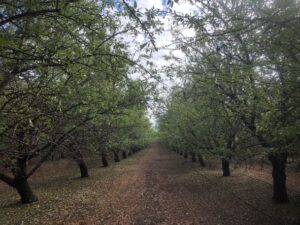By this time, mid-July leaf tissue sample results should be available. These tissue results are critical for any nutrient management plan. They should be taken annually to determine if the nutrient program is adequate for the orchard, and the values should be used to tune the orchard´s nutrient program.
Research has shown that once an orchard reaches sufficiency of a specific nutrient, increasing it further will not improve yields. This has been demonstrated several times, both within nitrogen and potassium. Second-guessing and adding more fertilizer beyond sufficient levels to address existing yield problems will not improve the situation. This fact is relatively unpopular as it is easier to add more fertilizer than it is to fix the problems that limit orchard production, or assure oneself during a period of second guessing. More on that can be found here (slide 17) and here (slide 20), and this article will focus on nitrogen
The typical nitrogen program often budgets for 20% of the nitrogen to be applied during the post-harvest period. Mid-summer leaf samples should be used to determine if the post-harvest fertility plan should be changed. Within nitrogen, leaf tissue samples that exceed 2.5% can reduce or even eliminate the need for postharvest nitrogen applications. This is based on:
- Many orchards with leaf levels above 2.5% often have high residual nitrogen within the soil that will meet post-harvest needs,
- The reduced transpiration rates of the postharvest period reduce uptake of nitrogen,
- There is significant canopy loss from the harvest process, reducing nitrogen uptake,
- Nitrogen remobilization back into perennial tissues is happening earlier than previously thought – probably sometime between hull-split and harvest (or maybe even earlier!).
Additionally, a long-term study in Arbuckle found that postharvest nitrogen applications did not improve yields in a reasonably high producing almond orchard. Nitrogen levels within this orchard were adequate to slightly excessive, depending on the year of the study.
If leaf tissue levels indicate nitrogen levels below 2.5%, then the planned post-harvest nitrogen program should be executed. Research suggests that the earlier the application, the more improved the chance of uptake and usage by the tree. Field trials have shown that a small amount of fertilizer applied through the summer and into harvest can be done without flaring hull-rot or harvest issues. These small applications (5lbs/acre/week or 5kg/ha/week) should be made frequently. If this isn’t possible, nitrogen should be applied as soon as harvest is over before canopy health declines.
Understanding the results of the leaf samples is helpful when determining the need for post-harvest nitrogen applications within almonds. If the tree is above the recommended range, reduce or eliminate the post-harvest nitrogen to reduce operational expenses. This is especially critical during high price input years, helping to maintain higher profitability.


Ash
August 21, 2022If you see a lot of fruiting buds at the end of August, do you still think there is a need to apply more nitrogen?
What else would the plants need ? Zinc perhaps?
Davidd
August 21, 2022Ash,
The additional nitrogen would only be needed if mid-summer leaf N was less than 2.5%, an and nitrogen applications failed to meet crop demand. In regards to other nutrients, we tend to include zinc and boron in our fall foliar spray, regardless of mid-summer tissue values.
David